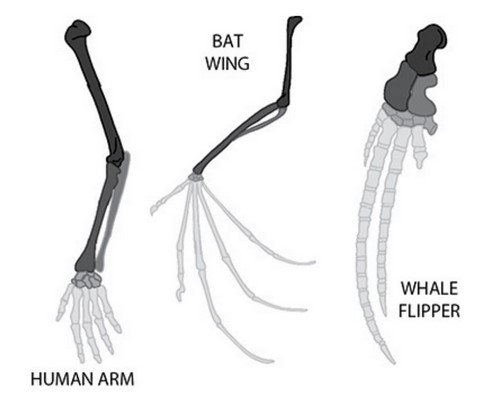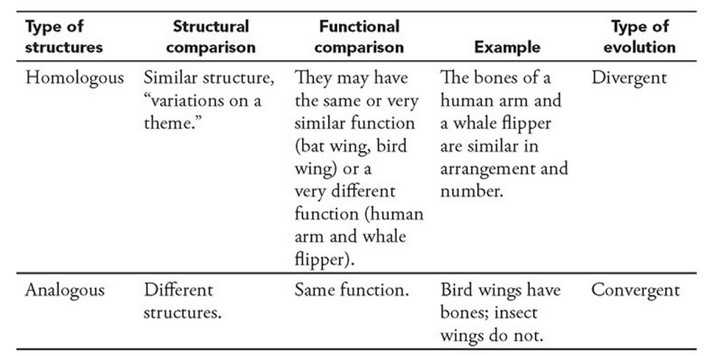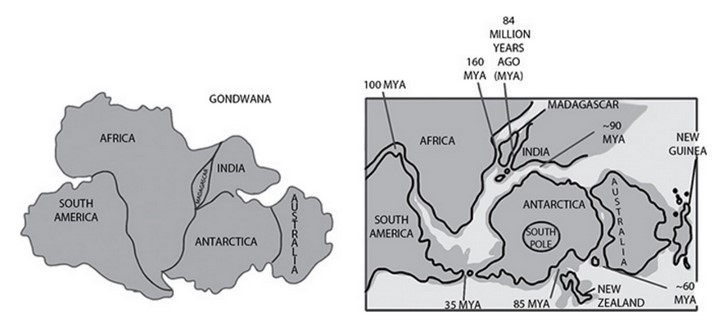Question
The following figure shows the bone structures of the limbs of a whale, a horse, and a human.
These are examples of which types of structures?
(A) analogous
(B) convergent
(C) homologous
(D) vestigial
▶️Answer/Explanation
Ans:
(C) Homologous structures indicate common ancestry but may have
different functions. Whales, horses, and humans are all mammals and
share common ancestry, but their limbs have different functions.
Analogous structures have similar functions. However, whale limbs are
used for swimming, horse limbs are used for trotting or running, and
human limbs are used for reaching and grasping; they do not have
similar functions, so choice (A) is incorrect. Choice (B) is incorrect
because convergent evolution results in analogous structures and does
not indicate common ancestry. Vestigial structures are structures in an
organism that have no current function but may have had a function in
an ancestral species, so choice (D) is incorrect.
Question

The structural similarities between the forelimbs shown in the figure above are evidence that:
(A) divergent evolution of a common ancestor occurred.
(B) humans are more closely related to bats than to whales.
(C) convergent evolution produces homologous structures.
(D) vertebrates show a limited number of body plans.
▶️Answer/Explanation
Ans: A
Humans, whales, and bats are all mammals (and therefore
vertebrates). The similarities in the bone structure of the forearm indicate
common ancestry. As divergence occurred, the resulting populations
adapted to their particular environments. For the bat, flight was an
advantage and for the whale, swimming. The differences in the structures
account for their different functions in different environments. (Though
birds’ and bats’ wings are also homologous; they have slightly different
structures and the same basic function.)
Stabilizing selection does not result in divergence, which is necessary
for speciation and the production of homologous structures. Ecological
succession is a relatively unrelated concept.
Homologous versus Analogous Structures
Question

In which layer would scientists be most likely to find the fossils of vertebrates making the transition from sea to land?
(A) layer D
(B) between layers D and C
(C) layer C
(D) between layers C and B
▶️Answer/Explanation
Ans: B
Layer D seems to contain only fish, but layer C appears to contain
tetrapods with fully developed limbs. The transition fossils are most
likely to be found between these two layers.
Question
When planning a fossil hunt for marine fossils of the Devonian period (354 million years ago), which of the following is the most crucial
aspect of planning?
(A) Make sure you pack the equipment used for radioactive dating.
(B) Locate sedimentary layers of 354 million years ago in coastal
regions.
(C) Find sites where sedimentary rocks of approximately 354 million
years ago are exposed and accessible.
(D) Collect fossils of various ages and place them in order of relative
age.
▶️Answer/Explanation
Ans: C
It is crucial to know where the rocks of the appropriate age are
exposed and accessible. Radioactive dating is not typically done on-site.
You want to know the location of the rocks of the age you’re studying
before you get there. Choice B is tempting but what is coastal now was not
necessarily coastal 354 million years ago, so knowing where the rocks that
were coastal back then are now, and making sure you can get to them, is the
most crucial aspect of planning of the four things listed.
Question
Refer to vicariance, a process by which the geographical range of an individual taxon, or a whole biota, is split into discontinuous parts by the formation of a physical or biotic barrier to gene flow or dispersal.
Gondwana is one of two supercontinents that formed from the breakup of Pangea. Gondwana included Antarctica, South America, Africa,
Madagascar, Australia, the Arabian Peninsula, and the Indian subcontinent.
The vicariance hypothesis proposes that the breakup of Gondwana isolated the descendants of a common ancestor of the Cichlidae, a large family of freshwater fishes.
Which of the following observations, if true, supports the vicariance
hypothesis for Cichlidae diversification?
(A) The time of origin for each clade (using DNA sequence data)
matches the times of separation of these land masses.
(B) The greatest DNA sequence similarities are found among the fish
closest to the oldest breakup site (160 million years ago) and the
greatest number of descendant species at the site of the newest
breakup (35 million years ago).
(C) The migration trail matches the path of the rifting plates.
(D) The greatest number of species at the newest breakup site.
▶️Answer/Explanation
Ans: A
Two processes, vicariance and dispersal, can explain the
distribution of many related organisms.
• Vicariance is the process by which the geographical range of one
or more taxa is split by the formation of a physical barrier that
reproductively isolates them. The process of vicariance typically
fragments a group, resulting in a widespread distribution of
descended species. The vicariance hypothesis is supported by data
that indicate the time of origin of the new taxa of Cichlidae
coincided with the separation of the land masses (choice A). This
suggests that the diversification was the result of the geographical
change. The times of origins of these clades that were estimated by
calibrating DNA sequence divergence by many different fish fossils
matches the sequence and times of separation of these land masses
in the Cretaceous.
• Dispersal is the process by which a species’ range increases over
time. The Psychotria genus established populations on all the
islands of Hawaii by means of dispersal. Choice D suggests, though
is not strong evidence for, dispersal. However, you shouldn’t assume
that a taxon originated in the place where it is presently most
diverse. See question 87 for a species whose distribution was
(formed) by dispersal.
Although these two processes are usually contrasted with each other,
there are many species in which they both occurred (often the breakup
precedes the dispersal).
Speciation does not require that the populations that dispersed or
were fragmented from the original population evolved by adaptation to
a new environment (natural selection). If there is no gene flow between
the populations, they may genetically drift independently of each other.
